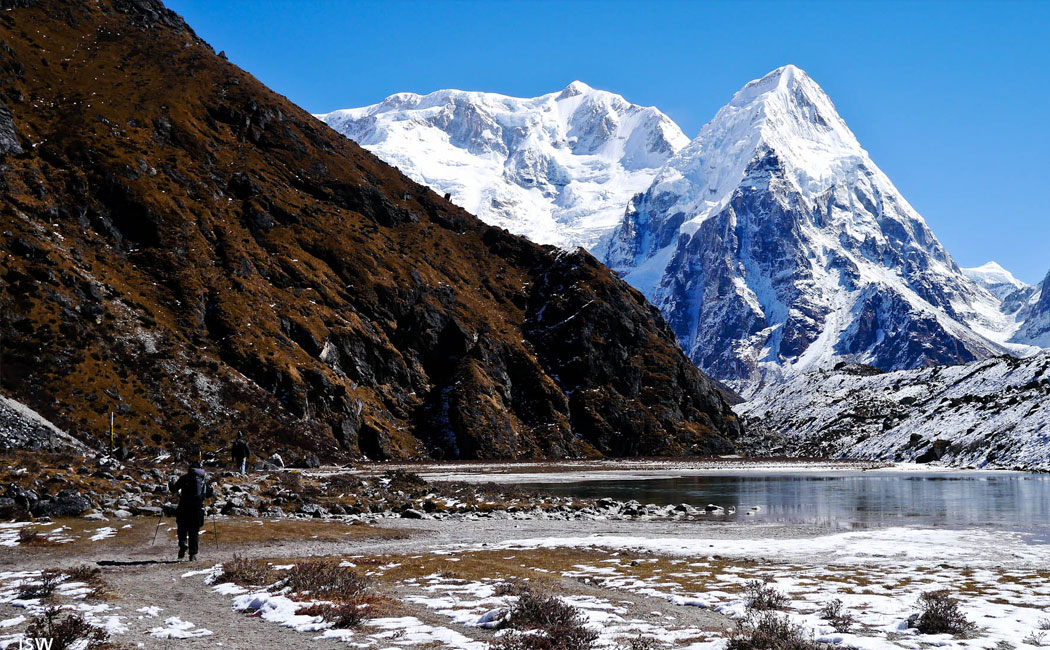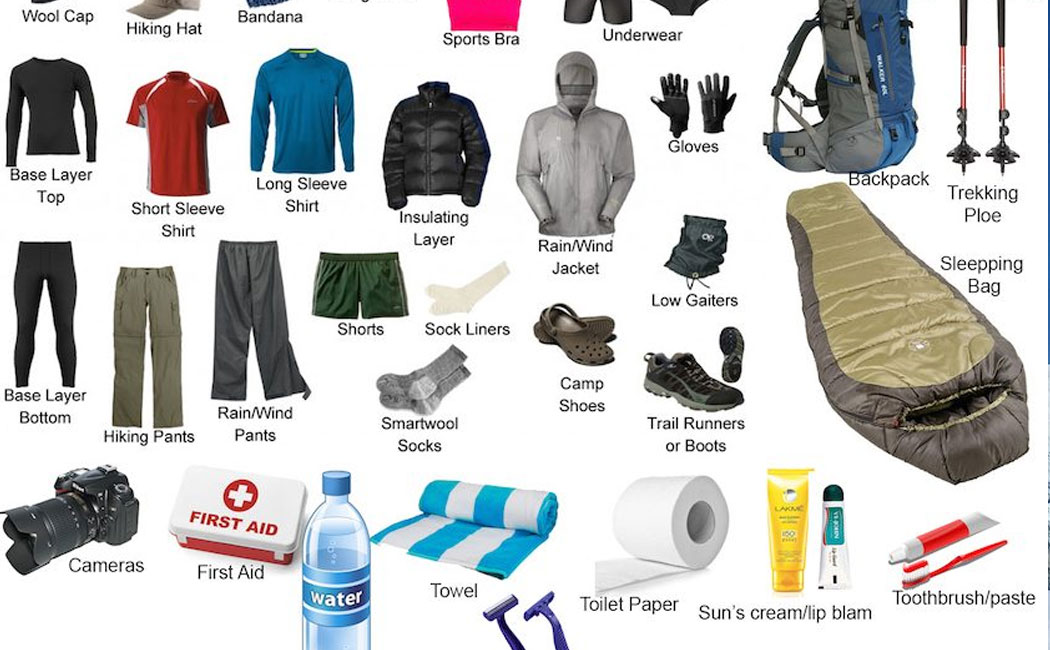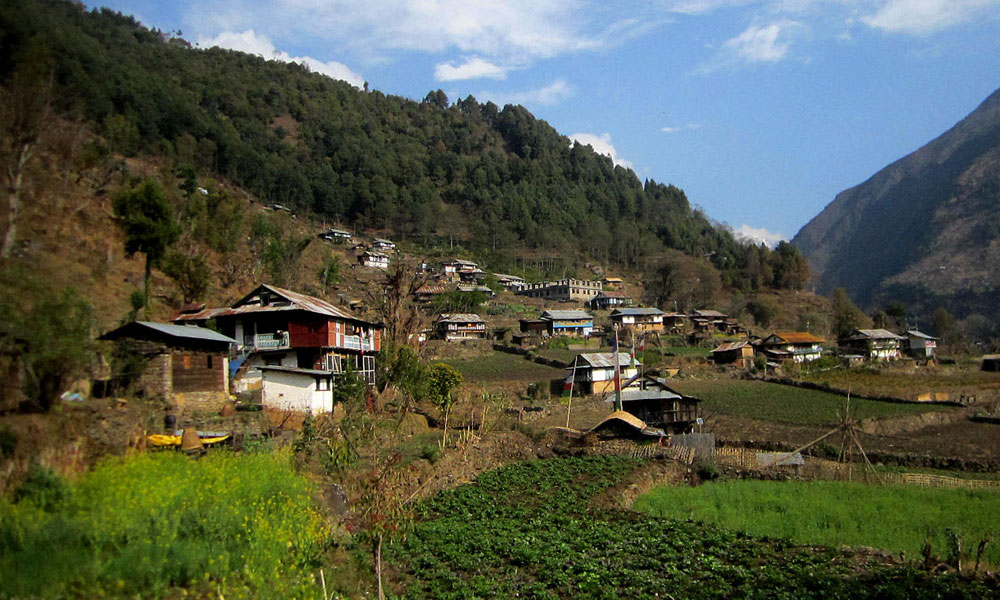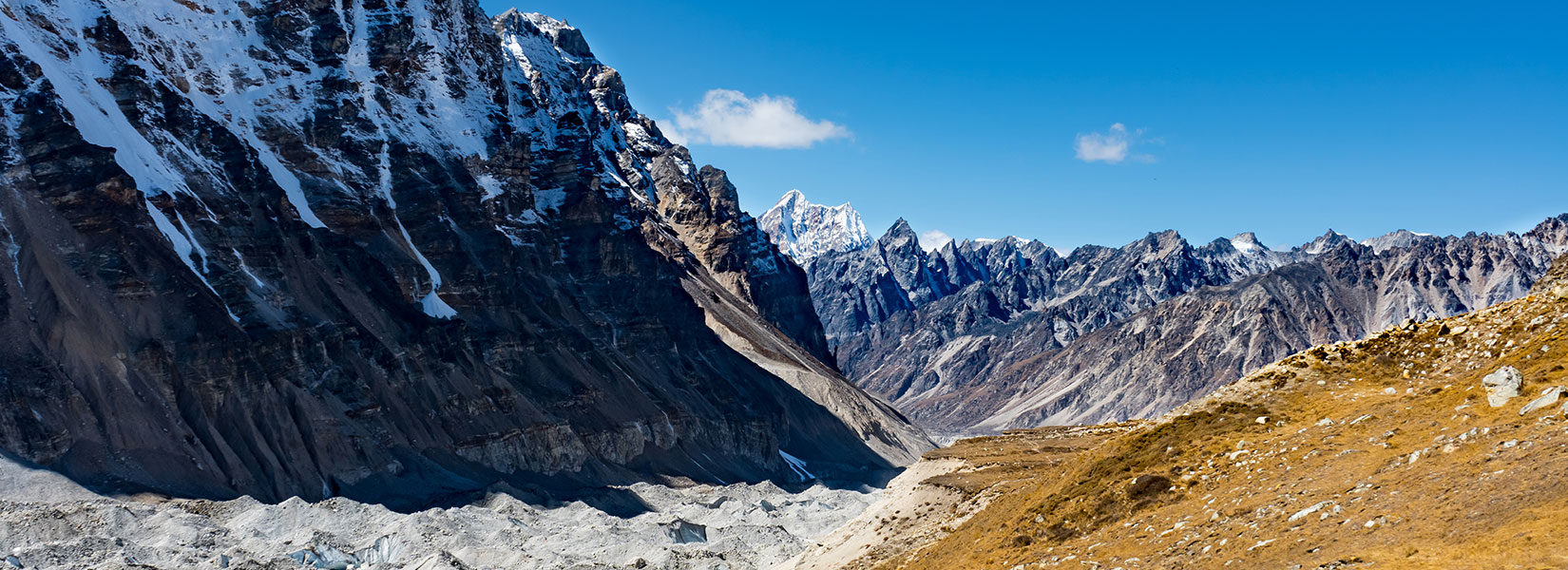Kanchenjunga Trek is an exhilarating adventure that offers spectacular views of the pristine landscapes and snow-capped mountains of Eastern Nepal. November is the last month of the autumn season, and taking part in this magnificent adventure this month will reward you with unforgettable and invigorating trekking experiences.
Embarking on this scenic adventure in November ensures an enjoyable and tranquil journey, providing you with an opportunity to trek through the alluring trails and immerse in the beauty of the Himalayas. November is the transitional month between winter and autumn, and you can experience the beauty and unique charm of both seasons in this month.
This incredible trek starts with an exciting flight from Kathmandu to Bhadrapur and takes you to scenic places like Ilam, Taplejung, Sinuwa, Taplethok, Sakathum, Amjilosa, Gyable, Ghunsa, Khambachen, Lhonak, Pangpema, Sele-la Kharka, Tseram, Oktang, Lamite Bhanjyang, Yamphudin, Phumphe, and Kunjari. Hiking to Pangpema (Kanchenjunga North Base Camp) and Kanchenjunga South Base Camp is the major highlight of the trek.
The clear and breathtaking views of the mountains, such as Kanchenjunga, Jannu, Kabru, Kirat Chuli, Talung, and many others, can be seen during November, which is fascinating. The favorable climatic conditions, excellent visibility, serene atmosphere, and stunning landscapes have made this autumn month stand out as one of the most preferred times for Kanchenjunga Base Camp Trekking.
Why Opt for the Kanchenjunga Trek in November?

Beautiful Sceneries
Kanchenjunga Region is the most charming in the autumn season. The landscapes are lush as they are nourished because of the rainfall in the preceding monsoon season, and it presents you with picturesque scenery. In the latter half of November, there may also be light snowfall in the high-altitude areas, allowing you to witness the beauty of winter wonderland. The beautiful and distinct views of Kanchenjunga, Kabru Peaks, Janu, Mera, and many other surrounding mountains are seen during the autumn month of November, which elevates your sightseeing experience. The pristine rivers, glaciers, and cascading waterfalls are the most vibrant in this autumn month, allowing you to witness the most surreal scenery of the beautiful Kanchenjunga Region.
Pleasant Weather
The autumn month of November rewards you with a delightful trekking environment. The weather in the daytime is moderate, especially in early November. The humidity level is low, and the air is refreshing. The weather is stable, and the trails are day, which makes traversing easier. The atmosphere of autumn is very calm, which creates a pleasant trekking environment. As the weather is stable, there aren’t many disruptions or chances of any unforeseen events happening, which allows you to trek while feeling the serenity of nature.
Clear Skies
November is the last autumn month and it presents the clearest sky and excellent visibility. There are fewer clouds in the sky, and you can witness the unobstructed views of the hills and beautiful snow-capped mountains. The days are mostly sunny, and the bright sunlight offers the most beautiful views of the unique landscapes of the Kanchenjunga Region. The uninterrupted and stunning views of the mountains, like Kanchenjunga, Kabru, and Tent Peaks, will enhance your traveling experience. You will get several opportunities to capture pictures of hills and snow-capped mountains and the awe-inspiring landscapes of Kanchenjunga in bright daylight. The clear and deep blue skies are one of the major perks of trekking to Kanchenjunga in November.
Weather and Temperature of Kanchenjunga Region in November
The weather is stable in the autumn month of November. The air is cool, and the skies are clear, which presents the ideal trekking environment and the panoramic views of snow-clad mountains. During the last days of November, the region gets colder as the winter season approaches, and also, the high-altitude zonesare usually cold, so it is highly recommended to pack warm clothes for a secure and comfortable journey. The daytime temperature of the lower zones ranges from 10°C to 22°C. In the higher zones, the temperature during the day can range from 1°C to 10 °C and can drop upto -11 °C at night.
Kanchenjunga Trekking Route and Itinerary

The Kanchenjunga Trek offers a chance to be in the different scenic places of Eastern Nepal. We have designed an interesting 27-day itinerary of Kanchenjua Base Camp Trekking including all the attractions of the trek. You will take the scenic flight from Kathmandu to Bhadrapur and enjoy the most scenic drive from Bhadrapur to Illam. The drive from Bhadrapur to Illam is one of the most delightful parts of the journey. You will travel through diverse terrains, from plain sections initially to the hilly section in a road full of turnings. The road to Ilam is mostly smooth, with beautiful views of hills, local markets, and tea gardens.
On the way to Ilam, you will reach a famous place called Kanyam. It is one of the most popular tourist spots in Eastern Nepal. You can witness the most beautiful views of tea gardens, lush hills, and charming houses from Kanyam. You can stop at the place for a while to observe the surroundings and have a local delicacy, i.e., Chayote dumplings. You will then continue your drive toward Ilam, where you will stay overnight. On the next day, you will again take an adventurous drive to Taplejung and also stay there for the night.
The trek starts early in the morning on the next day, and you will trek to Sinuwa with beautiful views of Mount Kanchenjunga and Kabru. You will continue your trek the next day, passing through charming villages and farms heading towards Taplethok. You will trek for four more days to places like Sakathum, Amjilosa, Gyable, and Ghunsa. Ghunsa is a charming village where you can witness beautiful houses built with stone. Your acclimatization day will be at Ghunsa village where you can hike to nearby scenic places. After the rest and acclimatization day, you will trek to Khambachen and Lhonak. The beautiful views of Mera Peak can be seen from Lhonak.
From Lhonak, you will hike to Pangpema (Kanchenjunga North Base Camp), which is one of the key highlights of the trek. The stunning views of Taple Sikhar, Kirat Chuli, and many other surrounding peaks can be seen along the way. As you arrive in the north base camp, your eyes will be blessed with the stunning views of Mt Kanchenjunga, Jannu, and many other surrounding peaks. After witnessing the grandeur of the Kanchenjunga region, you will trek back to Lhonak for an overnight stay.
You have already explored the beautiful Kanchenjunga North Base Camp, and now you will make your way towards Kanchenjunga South Base Camp, which also offers surreal views of the Kanchenjunga Region. To reach the south base camp, you will trek for three more days, passing through Ghunsa and Sele-la Kharka, crossing the thrilling Sele-la pass, and will reach Tseram.
From Tseram, you will hike to Kanchenjunga South Base Camp, with enchanting views of the pristine Yalung glacier. The beautiful views of Talung and Kabru peaks can be seen from the south base camp. After exploring the south base camp, you will trek to Ramche for an overnight stay. You will trek for six more days, passing through Tseram, Lamite Bhanjyang, Yamphudin, Phumphe, Kunjari, and Taplejung. Taplejung is the last place where you will cover the distance by foot. You will stay overnight in Taplejung.
On the next day you will drive to Birtamod from Taplejung, enjoying the beautiful scenery. Birtamod lies in the Jhapa district of Nepal and is a vibrant city with many restaurants and shopping centers. You will stay overnight in Birtamod. On the final day of the journey, you drive from Birtamod to Bhadrapur and arrive in Kathmandu, which marks the completion of this incredible Kanchenjunga Trek.
Packing List for Kanchenjunga Trek in November

November is the last month of the autumn season, and also a pre-winter month, which means by the end of the month, the weather starts to get colder. So, make sure to pack warm clothes to protect yourself from cold. Besides warm clothes there are many essentials that are required while traversing through the remote areas. The duration of the Kanchenjunga trek is longer, which can last 24 to 27 days. So, you will need to pack wisely, making a proper checklist. Here are our recommendations for Kanchenjunga Trek in November:
Clothing:
- Fleece Jackets
- Waterproof and Windproof Jackets
- Down Jackets
- Hiking T-shirts
- Hiking Pants
- Warm Caps
- Sunhats
- Scarf
- Gloves
- Undergarments
- Thermal Wears
- Rain Jackets
Footwear:
- Socks
- Hiking Boots
- Trekking Sandals
- Slippers
Trekking Gears:
- Backpack
- Sleeping Bag
- Flashlights
- Headlamps
- Trekking Poles
Other important items:
- First Aid Kit (Bandages and necessary medicines like paracetamols and pain relievers)
- Small mirror
- Map
- Hand Sanitizer
- Tissues and Wet Wipes
- Sunglasses
- High-energy snacks are bars
- Water Bottle
- Suncream
- Soap
- Towel
- Water purification tablets
- Cash
- Lip Balm
- Toothbrush and Toothpaste
- Insect Repellent
Accomodation and Meals during Kanchenjunga Trek in November

Kanchenjunga Trek takes you to remote trekking trails and off-the-beaten pathways. The region is still less visited than mainstream trekking destinations but there are good accommodation facilities available. Throughout the journey, you will stay in the teahouses and lodges. The facilities can get basic, especially in the higher zones, but the owners will make the best arrangements for you so that you can have a comfortable stay. The teahouses and lodges provide a cozy room with comfortable beds. You will get a pillow and blankets. As the higher zones are mostly cold, many trekkers also bring sleeping bags to ensure warmth and comfort. November is autumn month, which is considered the peak season. So, for a secure journey, it is important to book the accommodation in advance. If you book the trip with us, we will be responsible for all the arrangements for accommodation and meals during the journey.
You will be provided full board meals (Breakfast, Lunch, and Dinner) during the trek. The teahouses along the way also serve warm and hearty dishes. You will have a wholesome breakfast and dinner in tea houses, where you will stay and have lunch in tea houses along the trail. The most popular food item that is served in tea houses along the way is Dal Bhat (Rice, Lentils, veggies, and pickles). The meal is served warm and is very fulfilling which will keep you energized throughout the journey. The tea houses also serve a variety of other dishes like soup, thukpa, pasta, noodles, roti, bread, and many other dishes, which you can order according to your preference.
Kanchenjunga Trek Permit

Permits are essential for the Kanchenjunga Trek. During the Kanchenjunga trek, you will be walking through the rugged and varied terrains for numerous days. As the trail is still remote and passes through the protected area, you will need a permit for trekking. The permits are necessary for keeping records of the tourists to ensure their safety. The revenue collected from the permit is used for the development of the local infrastructure and preservation of the natural resources and cultural heritage of the region. To trek in Kanchenjunga, you need two permits, and they are:
- Kanchenjunga Restricted Area Permit
- Kanchenjunga Conservation Area Project
The Kanchenjunga Restricted Area Permit costs US$ 20 per person each week for the first four weeks and US$ 25 for each additional week. The cost of the Kanchenjunga Conservation Area permit is US$ 20.
Gain Insights On:
Altitude Sickness and Preventive Measures

While venturing into a high-altitude adventure like trekking, the risk of altitude sickness is one of the major concerns. During the Kanchenjunga trek, you will cover long distances on foot, walking through the different elevation points. As you will be Trekking at such a high altitude, you need to get accustomed to the changing environment. When your body can’t adapt to the high-altitudes, the risk of experiencing the symptoms of altitude sickness increases. Some symptoms of altitude sickness are:
- Headache
- Nausea and Vomiting
- Having difficulties sleeping
- Blocked Ears
- Lack of appetite
- Fatigue
You can reduce the risk of altitude sickness by following some measures.
Some of the preventive measures of Altitude sickness are:
- Trek gradually; do not hurry
- Be cautious about how your body is reacting to the high altitude.
- Incorporate rest days, allowing your body to get accustomed to the changing altitudes.
- Maintain proper hydration and nutrition.
- There are medications available to prevent the symptoms of altitude sickness, which you can take after consulting with the doctor.
- Inform the guides immediately in case of any discomfort during the journey.
Travel Insurance
Travel insurance is important for Kanchenjunga Trek. While trekking is adventurous and scenic, there are also possible risks that come along. To stay financially protected from such risks, travel insurance is essential. So, it is highly recommended to choose an insurance policy that provides coverage against the following risks:
- Lost or Stolen Luggage.
- Trip disruption because of natural calamities.
- Helicopter evacuation in case of emergencies
- Trip cancellation or delays.
- Medical expenses because of any injuries or illness during the trek.
Some tips for the Kanchenjunga Trek in November

Research
Research is important before heading to high-altitude adventures like trekking. When you conduct proper research, you will be familiar with the trail conditions, the ideal time for a visit and also an idea about the budget that is needed for the trek. You can either read about the trek on different blogs or watch the videos online. Similarly, you can also contact the trekking agency directly and inquire about the trek.
Researching allows you to learn about the nature of the trek, the topography of the region and special attractions which will help you be well prepared about the trek. So, it is highly recommended to conduct research and plan accordingly.
Incorporate Training and Exercises
Kanchenjunga Trek takes you to varied terrains, and a good level of physical fitness is required for trekking. To develop stamina and endurance, you can do some training and exercises which will help you stay fit. You can incorporate strength training and cardiovascular exercises some weeks before you start the trek. The exercises help you with mobility, balance, and maintain stability, which is essential for high-altitude trekking. Some of strength exercises that you can incorporate into your routine are Pull-ups, push-ups, planks, squats, deadlifts, calf raises, etc. Similarly, cardiovascular exercises like swimming, jogging, cycling, stair climbing, and walking can also help to build the stamina and endurance that is essential while trekking.
It is also highly recommended to go on hikes around the local area before embarking on the trek. Hiking is one of the best forms of practice before venturing into high-altitude adventures. It makes you familiar with the navigation and about the challenges that are common during the trek.
Maintain Hydration and Nutrition
Hydration and nutrition is essential during trekking. As you will cover long distances by walking through the wavy and uneven paths in most parts of the trek, you need stamina and energy. So, make sure to ensure proper hydration and have nutritious food. Usually trekkers carry a Reusable water bottle and fill it in the teahouses they stay or have lunch at. You can also ask about the usage of water filtration tablets with the guides. Maintaining hydration and nutrition will help you stay energized and fit throughout the trek.
Acclimatization
Acclimatization is the process of getting accustomed to the change in the environment. One of the most important parts that should be highly focused on during the high-altitude treks is acclimatization. You should let your body get adjusted to the changing environment. On acclimatization day, you can explore the nearby places to adapt to the high-altitude. Incorporating acclimatization days is necessary during trekking to minimize the risk of altitude sickness and ensure a safe journey.
Communicate with the Guides
It is important to have proper communication with the guides during the high-altitude treks. When you have an interactive journey, the duration of the trek feels shorter. In addition, the guides can understand your needs and requirements better and make arrangements accordingly when you communicate with them. So, make sure to properly communicate with the guide for an enjoyable and immersive journey.
Be well-informed about the itinerary.
It is highly recommended to know the itinerary of the Kanchenjunga Trek before embarking on the journey. When you know your itinerary and routes, you will be well prepared for the journey and can distribute the time of the walk and rest accordingly, which will help you reach the destination in a predetermined time. Knowing about the itinerary helps you to understand the special attractions of the trek better. You can visualize what you are going to expect during the journey and also be ready for the possible challenges that come along in certain sections and prepare accordingly to conclude the trek successfully.

